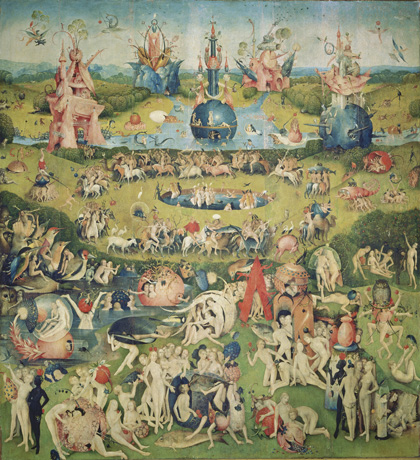Fr : version française / En: english version
mheu, Historical Museum of the Urban Environment
The Garden of Earthly Delights
Hieronymus Bosch

1510
220cm x 195cm
painting on wood (triptych)
Museo del Prado, Madrid, Spain
© Hans Hinz - ARTOTHEK
View this work in the exhibition Bathing
The work
The Garden of Earthly Delights, a triptych painted between 1500 and 1505, is a marvelous example of this format. Bosch adds colorful characters and imaginative creatures to the biblical description. These elaborate creations, often amusing and earthy, sometimes coarse, remain somewhat mysterious, for although some are references to proverbs and folk legends, others belong to the world of alchemy and hermeticism. However, this picturesque side must not divert us from the fact that originally the work was meant to frighten: it showed in great detail those who had given themselves over to sin and whose souls would be damned as a result. In spite of the glowing colors, the subject of this middle panel, between two side panels, one representing Genesis and the other Adam and Eve in the Garden of Eden, is the terror of Hell.
The artist
Like many artists in the Middle Ages, his surname is taken from the town where he was born, around 1450:'s-Hertogenbosch. Hieronymus Bosch remained here all his life. In 1480 he married the daughter of an aristocrat, joined a religious brotherhood for which he was also official painter, and lived a peaceful life in this small Flemish town in the Duchy of Brabant until his death in 1516. This unadventurous existence, scarcely disrupted by a journey to Venice in the early 1500s, did not prevent his work from gaining recognition throughout Europe—he was known in Spain by the name El Bosco and in Italy as Bosco di Balduc. He was a moralist, whose work was perhaps influenced by that of Jan van Ruysbroeck, a 14th-century mystical writer. We can assume that Bosch's style of painting, which was to influence a great many artists (one of the most prominent being the great Brueghel the Elder), this new way of portraying vice and sin, the use of satire and humor, at once astonished, disconcerted and enchanted his contemporaries.